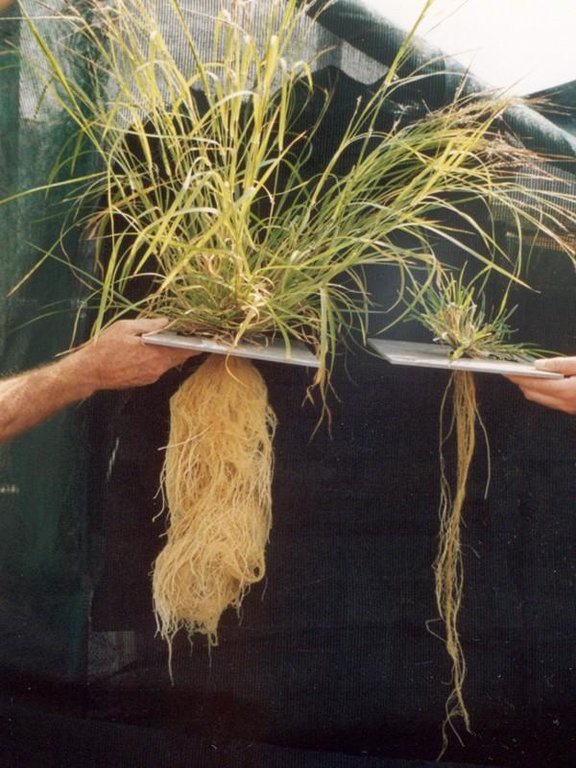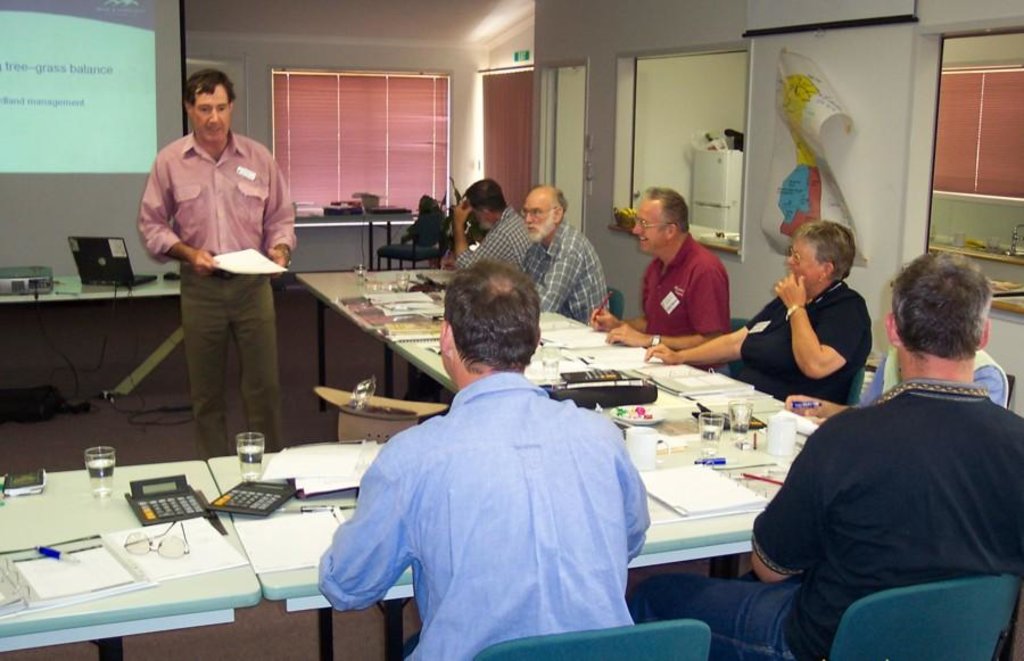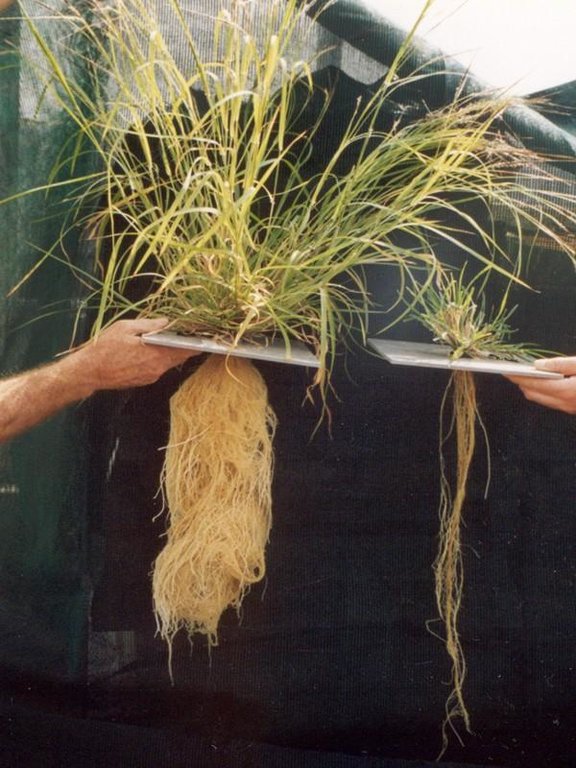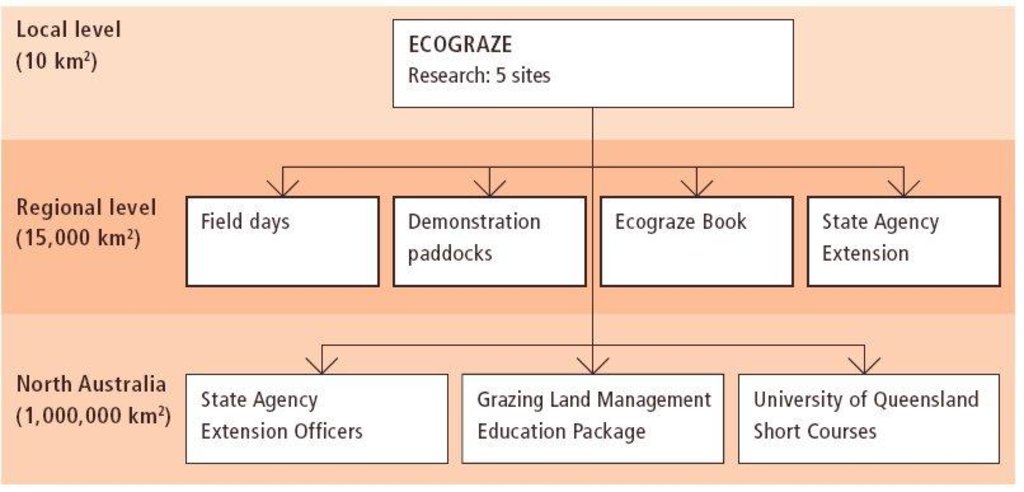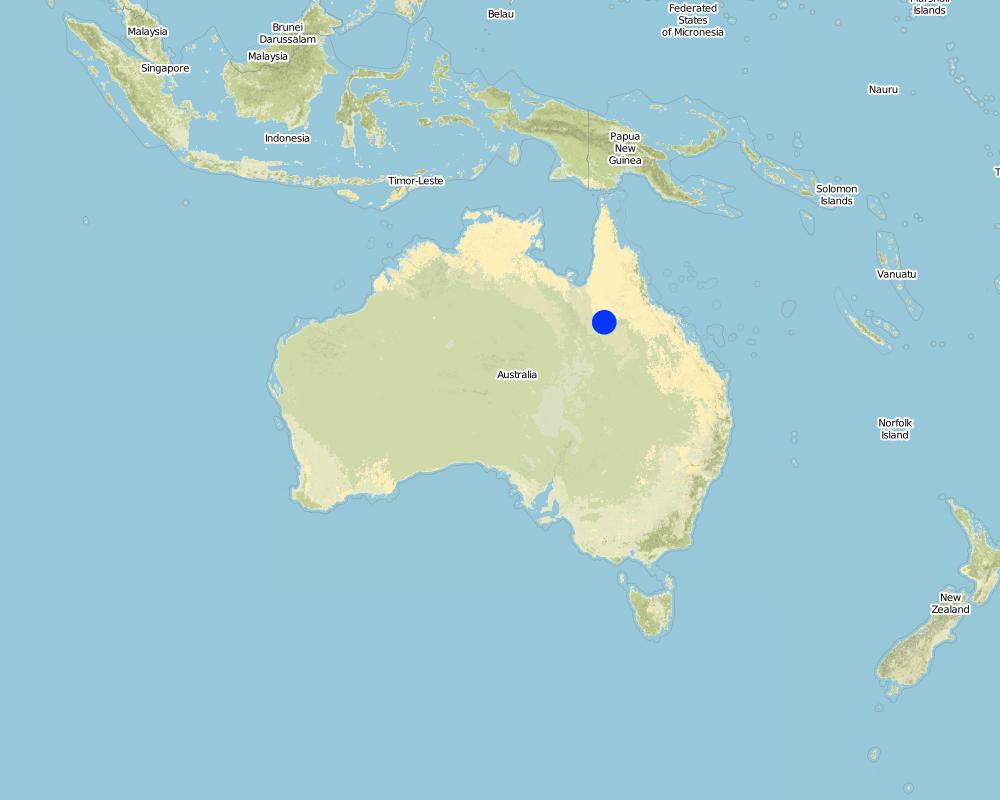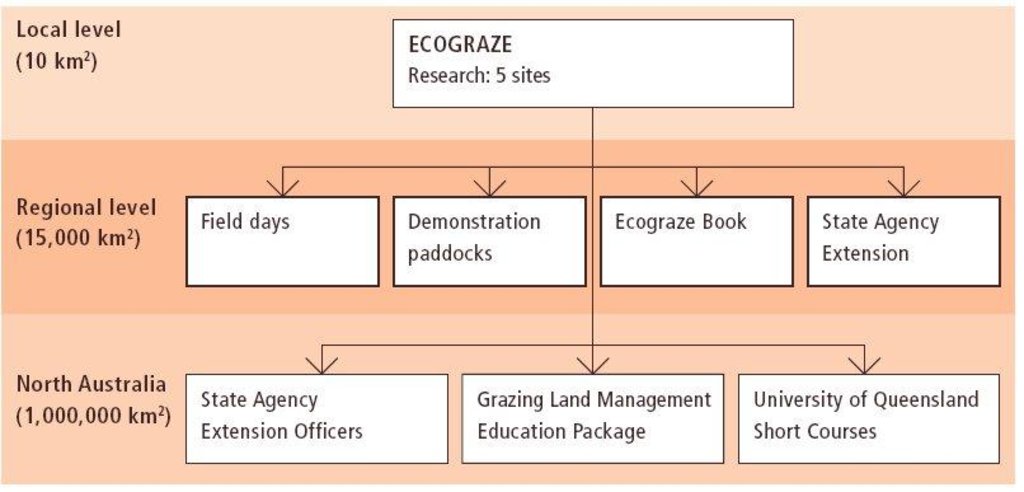Development and promotion of Ecograze [ออสเตรเลีย]
- ผู้สร้างสรรค์:
- การอัพเดท:
- ผู้รวบรวม: Andrew Ash
- ผู้เรียบเรียง: –
- ผู้ตรวจสอบ: David Streiff, Deborah Niggli
approaches_2333 - ออสเตรเลีย
ดูส่วนย่อย
ขยายทั้งหมด ย่อทั้งหมด1. ข้อมูลทั่วไป
1.2 รายละเอียดที่ติดต่อได้ของผู้รวบรวมและองค์กรที่เกี่ยวข้องในการประเมินและการจัดเตรียมทำเอกสารของแนวทาง
ชื่อของโครงการซึ่งอำนวยความสะดวกในการทำเอกสารหรือการประเมินแนวทาง (ถ้าเกี่ยวข้อง)
Book project: where the land is greener - Case Studies and Analysis of Soil and Water Conservation Initiatives Worldwide (where the land is greener)ชื่อของโครงการซึ่งอำนวยความสะดวกในการทำเอกสารหรือการประเมินแนวทาง (ถ้าเกี่ยวข้อง)
CSIRO (CSIRO) - ออสเตรเลีย1.3 เงื่อนไขที่เกี่ยวข้องกับการใช้ข้อมูลที่ได้บันทึกไว้ผ่านทาง WOCAT
ผู้รวบรวมและวิทยากรหลักยอมรับเงื่อนไขเกี่ยวกับการใช้ข้อมูลที่ถูกบันทึกผ่านทาง WOCAT:
ใช่
1.4 การอ้างอิงถึงแบบสอบถามเรื่องเทคโนโลยี SLM
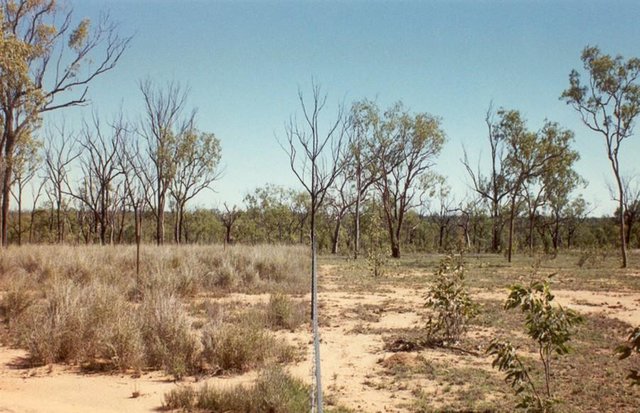
Ecograze [ออสเตรเลีย]
An ecologically sound and practical grazing management system, based on rotation and wet season resting.
- ผู้รวบรวม: Andrew Ash
2. คำอธิบายของแนวทาง SLM
2.1 การอธิบายแบบสั้น ๆ ของแนวทาง
Research-based development and promotion of Ecograze principles and practices through on-farm testing and demonstration.
2.2 การอธิบายอย่างละเอียดของแนวทาง
การอธิบายอย่างละเอียดของแนวทาง:
Aims / objectives: In 1992, Meat and Livestock Australia (MLA), a producer-owned company that provides services to the entire Australian red meat industry, initiated the Ecograze project. Ecograze was intended to provide innovative management options for the pastures in the eucalyptus woodlands of north-east Queensland. It was an eight-year collaborative research project undertaken by staff of the CSIRO (Commonwealth Scientific and Industrial Research Organisation) Sustainable Ecosystems and Queensland Department of Primary Industries with input from Queensland Department of Natural Resources and Mines. It formally concluded in 2001. However, many of the analyses and extension activities have been ongoing since then.
Methods: Ecograze was conducted on five commercial grazing properties that spanned different conditions and consequently allowed extrapolation of results to a much wider area across northern Australia. Practical grazing management strategies have been developed. The Ecograze team assessed the economic implications of managing land in various states by linking a pasture production model, to a model of farm economics. Research teams are currently testing the grazing management technology in commercial situations to understand the real costs and implications of implementing the research-derived Ecograze recommendations. The on-farm tests are supported by a number of new initiatives. These include a MLA funded project to specifically implement the Ecograze principles on farms as a means of reducing sediment and nutrients pollution of waterbodies. The National Action Plan for Salinity and Water Quality, through incentives, supports land management practices to reduce erosion, increase ground cover and minimise runoff. Funding is also provided by the Natural Heritage Trust to fence and sub-divide paddocks. All of these initiatives are supported by State Government agencies, who have extension staff based in the regions to assist farmers with implementing new practices. In the case of Ecograze, there are extension officers in the NE Queensland region who are actively promoting its management principles and are assisting producers in planning new strategies. Many of the Ecograze principles are also included in a new Grazing Land Management (GLM) Education package, developed by MLA and research and development agencies. The GLM package, which is delivered via a three-day workshop, is being extended to producers across northern Australia.
This approach highlights the importance of active collaboration between researchers, farmers, the beef industry and the government - in this case to develop a system to improve the condition of grazing lands. Through the central involvement of research, management options have been identified to suit different land users' needs, climates, grazing pressures and pasture conditions
2.3 รูปภาพของแนวทาง
2.5 ประเทศ ภูมิภาค หรือสถานที่ตั้งที่ได้นำแนวทางไปใช้
ประเทศ:
ออสเตรเลีย
ภูมิภาค/รัฐ/จังหวัด: :
Northern Australia
ข้อมูลเฉพาะเพิ่มเติมของสถานที่ตั้ง:
Queensland
Map
×2.6 วันที่เริ่มต้นและสิ้นสุดของแนวทาง
ระบุปีที่เริ่ม:
1992
การสิ้นสุดลง (ถ้าแนวทางไม่ได้ใช้อีกต่อไป):
2001
2.7 ประเภทของแนวทาง
- ใช้โครงงานหรือแผนงานเป็นฐาน
2.8 เป้าหมายหรือวัตถุประสงค์หลักของแนวทาง
The Approach focused on SLM only
Development and promotion of Ecograze principles leading to adoption and thereby enhancing pasture productivity, soil condition and improved livelihoods for pastoralists.
The SLM Approach addressed the following problems: (1) Poor rangeland management leading to loss of productive palatable perennial grasses (3 P grasses) resulting in reduced ground cover, soil erosion, profit loss and in some cases irreversible land degradation. (2) Lack of understanding of underlying problems regarding mismatch of animal numbers to forage supply (pressure on grazing land) in a highly variable climate. (3) No clear technical recommendations regarding resting and rotation of rangeland
2.9 เงื่อนไขที่เอื้ออำนวยหรือเป็นอุปสรรคต่อการนำเทคโนโลยีภายใต้แนวทางนี้ไปปฏิบัติใช้
บรรทัดฐานและค่านิยมทางสังคม วัฒนธรรม ศาสนา
- เป็นอุปสรรค
Many pastoralists are conservative and change their systems only slowly.
Treatment through the SLM Approach: There are ongoing education programmes and demonstrations on target properties.
การมีไว้ให้หรือการเข้าถึงแหล่งการเงินและบริการ
- เป็นอุปสรรค
Investment costs for fencing and water points can be burden on individual land holders.
Treatment through the SLM Approach: There are various possible subsidies available (see 'Inputs', under 'Incentives').
กรอบแนวทางในการดำเนินการด้านกฎหมาย (การถือครองที่ดิน สิทธิในการใช้ที่ดินและน้ำ)
- เอื้ออำนวย
The existing land ownership, land use rights / water rights helped a little the approach implementation: In general, implementation of Ecograze principles is undertaken by an individual on private leasehold land. Ecograze is well suited to this individualised system.
3. การมีส่วนร่วมและบทบาทของผู้มีส่วนได้ส่วนเสียที่เกี่ยวข้อง
3.1 ผู้มีส่วนได้ส่วนเสียที่เกี่ยวข้องในแนวทางนี้และบทบาท
- ผู้ใช้ที่ดินระดับท้องถิ่นหรือชุมชนระดับท้องถิ่น
Traditionally, men undertake on-farm planning, implementation of activities and provide labour. Women play an important role in planning and management of finances, and tend to take a more strategic view on NRM issues than the men.
- รัฐบาลแห่งชาติ (ผู้วางแผน ผู้ทำการตัดสินใจ)
- Govt. agencies/extensionistes
3.2 การเกี่ยวข้องของผู้ใช้ที่ดินระดับท้องถิ่นหรือชุมชนระดับท้องถิ่นในช่วงต่างๆของแนวทาง
| ความเกี่ยวข้องของผู้ใช้ที่ดินระดับท้องถิ่นหรือชุมชนระดับท้องถิ่น | ระบุผู้ที่มีส่วนเกี่ยวข้องและอธิบายกิจกรรม | |
|---|---|---|
| การริเริ่มหรือการจูงใจ | ไม่ลงมือ | workshops/seminars, field days |
| การวางแผน | ระดมกำลังด้วยตนเอง | consultation with specialists |
| การดำเนินการ | ระดมกำลังด้วยตนเอง | fencing and water points |
| การติดตามตรวจสอบหรือการประเมินผล | ระดมกำลังด้วยตนเอง | field observations; field observations of pasture composition; economic assessments |
| Research | ปฏิสัมพันธ์ | on-farm; on-farm field trials and demonstration areas |
3.3 แผนผังแสดงขั้นตอนการทำงาน (ถ้ามี)
คำอธิบาย:
Programme organization: Components and activities at different levels of the Ecograze programme.
3.4 การตัดสินใจเลือกใช้เทคโนโลยี SLM
ระบุผู้ที่ทำการตัดสินใจเลือกเทคโนโลยีมากกว่าหนึ่งวิธีไปปฏิบัติใช้:
- ผู้ใช้ที่ดินเป็นผู้ตัดสินใจหลัก โดยการสนับสนุนจากผู้เชี่ยวชาญ SLM
การอธิบาย:
Mainly made by land users in consultation with technology experts and government agencies; recognition that Ecograze principles can benefit land users and the environment due to research results of field trials.
Decisions on the method of implementing the SLM Technology were made by by land users* alone (self-initiative / bottom-up). Mainly made by land users.
4. การสนับสนุนด้านเทคนิค การสร้างขีดความสามารถ และการจัดการด้านความรู้
4.1 การสร้างขีดความสามารถ / การอบรม
ได้มีการจัดอบรมให้แก่ผู้ใช้ที่ดินหรือผู้มีส่วนได้ส่วนเสียคนอื่น ๆ หรือไม่:
ใช่
รูปแบบการอบรม:
- จัดคอร์ส
หัวข้อที่พูด:
The Ecograze principles and findings have been incorporated into a training course entitled 'Grazing Land Management (GLM) Education Package'. To date (2005) over 100 farmers have participated in the course and it is anticipated that in the next three years this number will reach over 1,000 producers.
4.2 การบริการให้คำแนะนำ
ผู้ใช้ที่ดินมีการเข้าถึงการรับบริการให้คำปรึกษาหรือไม่:
ใช่
ระบุว่ามีบริการให้คำปรึกษาหรือไม่:
- ไปเยี่ยมชมสถานที่
- ที่ศูนย์ถาวร
การอธิบาย/แสดงความคิดเห็น:
Key elements: In on-going research trials in cooperation with land-users, government officers build up their knowledge and capacity to support farmers . Field days form part of the extension and education process. , Government assistance with extension and training through free advice provided by extension officers is helpful, Subsidies to attend training courses like GLM Education also assist with the uptake and adoption of Ecograze. ; There is also a significant interaction between neighbouring properties in sharing of ideas and successes and failures. Commonly, these neighbouring properties are linked through catchment or a Landcare groups.
4.3 การเสริมความแข็งแกร่งให้กับสถาบัน (การพัฒนาองค์กร)
สถาบันได้รับการจัดตั้งขึ้นมาหรือเสริมความแข็งแกร่งโดยแนวทางนี้หรือไม่:
- ใช่ เล็กน้อย
ระบุระดับของสถาบันที่ได้รับการเสริมความแข็งแกร่งหรือจัดตั้งขึ้นมา:
- ท้องถิ่น
ระบุประเภทของการให้ความช่วยเหลือสนับสนุน:
- ด้านการเงิน
ให้รายละเอียดเพิ่มเติม :
financial (see Annex A3)
4.4 การติดตามตรวจสอบและประเมินผล
การติดตามตรวจสอบและประเมินผลเป็นส่วนหนึ่งของแนวทางหรือไม่:
ใช่
ความคิดเห็น:
Bio-physical aspects were regular monitored by 0 through measurements
Socio-cultural aspects were ad hoc monitored by land users through observations
Economic / production aspects were regular monitored by 0 through measurements;
Area treated aspects were ad hoc monitored by 0 through measurements
No. of land users involved aspects were ad hoc monitored by project staff through measurements
There were no changes in the Approach as a result of monitoring and evaluation: Further research and testing, on-going monitoring and evaluation is underway after the initial project. It is too early to state what changes are likely other than obviously needing to adapt to individual land-users resources and available finances.
4.5 การวิจัย
การวิจัยเป็นส่วนหนึ่งของแนวทางหรือไม่:
ใช่
ระบุหัวข้อเรื่อง:
- เศรษฐศาสตร์หรือการตลาด
- เทคโนโลยี
ให้ข้อมูลเพิ่มเติมและให้ระบุผู้ทำการวิจัย:
The impact of the ongoing research on understanding and implementing the technology through the Ecograze project is significant, and continues to be so. Research into various technical aspects of grazing management has been recently supplemented by economic analyses of costs and benefits.
5. การสนับสนุนด้านการเงินและวัสดุอุปกรณ์
5.1 ระบุงบประมาณประจำปีสำหรับแนวทาง SLM นี้
แสดงความคิดเห็น (แหล่งของการระดมทุน ผู้บริจาคคนสำคัญ):
Approach costs were met by the following donors: government (national government): 40.0%; local community / land user(s) (community / local): 60.0%
5.2 การสนับสนุนด้านการเงิน / วัสดุอุปกรณ์ให้แก่ผู้ใช้ที่ดิน
ผู้ใช้ที่ดินได้รับการสนับสนุนด้านการเงิน / วัสดุอุปกรณ์ไปปฏิบัติใช้เทคโนโลยีหรือไม่:
ใช่
ถ้าใช่ ให้ระบุประเภทของการสนับสนุน เงื่อนไขและผู้จัดหามาให้:
Local Landcare groups often request assistance, and this is provided either from the research agencies or from extension officers or through grant applications to the Natural Heritage Trust.
5.3 เงินสนับสนุนสำหรับปัจจัยนำเข้า (รวมถึงแรงงาน)
- ไม่มี
ถ้าแรงงานโดยผู้ใช้ที่ดินเป็นปัจจัยนำเข้าที่มีอยู่มากมาย ระบุด้วยว่าเนื่องจาก:
- สมัครใจ
5.4 เครดิต
มีการจัดหาเครดิตมาให้ภายใต้แนวทาง SLM หรือไม่:
ไม่ใช่
5.5 แรงจูงใจหรือเครื่องมืออื่น ๆ
แรงจูงใจหรือเครื่องมืออื่น ๆ ได้ถูกนำไปใช้ส่งเสริมการใช้เทคโนโลยี SLM หรือไม่:
ใช่
ถ้าใช่ ระบุ:
During the research phase of Ecograze, incentives were not available. However, since then, newly established Government initiatives such as the Natural Heritage Trust and the National Action Plan for Salinity and Water Quality, which commenced in 2003, have increased the number of incentives (eg support for on-ground works such as fencing, relocation of water points etc) available to implement management practices such as those recommended in Ecograze.
6. การวิเคราะห์ผลกระทบและการสรุป
6.1 ผลกระทบของแนวทาง
ช่วยให้ผู้ใช้ที่ดินนำเอาเทคโนโลยี SLMไปใช้และบำรุงรักษาสภาพไว้ได้หรือไม่:
- ไม่ใช่
- ใช่ เล็กน้อย
- ใช่ ปานกลาง
- ใช่ อย่างมาก
Ecograze leads to retention of 3P grasses ('perennial, productive and palatable' grasses), and therefore better pasture coverage, soil retention and greater water use efficiency.
Did other land users / projects adopt the Approach?
- ไม่ใช่
- ใช่ เล็กน้อย
- ใช่ ปานกลาง
- ใช่ อย่างมาก
Ecograze principles have been included in the new Grazing Land Management Education package - which is being used across northern Australia by Meat and Livestock Australia and other agencies also. It has also now been incorporated into university courses on grazing management.
6.3 ความยั่งยืนของกิจกรรมของแนวทาง
ผู้ใช้ที่ดินสามารถทำให้สิ่งต่างๆ ที่ได้ปฏิบัติใช้โดยแนวทางนี้ยั่งยืนได้หรือไม่ (โดยไม่มีการสนับสนุนจากภายนอก):
- ใช่
ถ้าตอบว่าใช่ ให้อธิบายว่าอย่างไร :
Progress is continuing with further field trials and participation from land users. Those land users who have begun with the Ecograze system can continue without external support.
6.4 จุดแข็งและข้อได้เปรียบของแนวทาง
| จุดแข็ง / ข้อได้เปรียบของแนวทางในทัศนคติของผู้รวบรวมหรือวิทยากรหลัก |
|---|
| Adoption of the technology should result in financial reward. (How to sustain/ enhance this strength: Continue ongoing economic analysis as an indication of technology success.) |
| The system has been very well documented and adapted to the land users conditions through the involvement of research, the land users, primary industry, and extension. (How to sustain/ enhance this strength: Continued support for applied/on-farm research to adapt the system to the needs of the land users and the environment. Support for long-term monitoring.) |
| State government extension agencies have also readily accepted Ecograze and are actively promoting its principles with landholders. |
| The approach is focussed on changing attitudes to management in the long term. (How to sustain/ enhance this strength: Continue with training and education programmes.) |
6.5 จุดอ่อน / ข้อเสียเปรียบของแนวทางและวิธีในการแก้ไข
| จุดอ่อน / ข้อเสียเปรียบในทัศนคติของผู้รวบรวมหรือวิทยากรหลัก | สามารถแก้ไขปัญหาได้อย่างไร |
|---|---|
| One-off training programs such as the Grazing Land Management Education package (a 3-day course) may not be enough to sustain initial commitment to testing new management options. | Create support network and supply follow-up training and/or support. |
7. การอ้างอิงและการเชื่อมต่อ
7.1 วิธีการหรือแหล่งข้อมูล
- ไปเยี่ยมชมภาคสนาม การสำรวจพื้นที่ภาคสนาม
- การสัมภาษณ์กับผู้ใช้ที่ดิน
7.2 การอ้างอิงถึงสิ่งตีพิมพ์
ชื่อเรื่อง ผู้เขียน ปี ISBN:
Ash A, Corfield J and Taoufik T (undated) The ECOGRAZE Project: developing guidelines to better manage grazing country. CSIRO, Meat and Livestock Commission and Queensland Government
ลิงก์และโมดูล
ขยายทั้งหมด ย่อทั้งหมดลิงก์

Ecograze [ออสเตรเลีย]
An ecologically sound and practical grazing management system, based on rotation and wet season resting.
- ผู้รวบรวม: Andrew Ash
โมดูล
ไม่มีโมดูล



